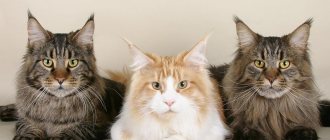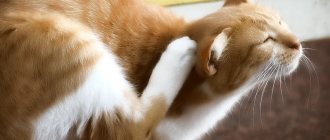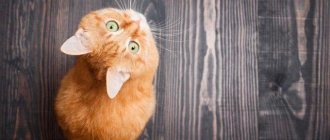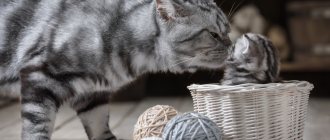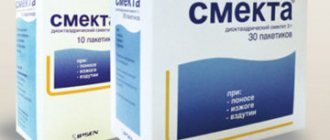An owner who cares for his pet should determine his well-being by the appearance of the animal. A cat's wet nose is considered a sign of health. The condition of the tip of a cat's nose is some indicator of the health or illness of the animal. A more accurate diagnosis, of course, can only be made by a veterinarian, whom you should contact if you suspect a disease.
Norm or pathology
The sense of smell in cats is the main sense organ.
An animal that has difficulty smelling becomes lethargic, has poor spatial orientation, and loses its appetite. If the olfactory organ is moist and cool, this means that the pet is healthy .
Due to the emotional state, physical activity, and climatic conditions, indicators can change over time, but this is not always a sign of pathology.
Minor dryness goes away on its own or after favorable conditions are created.
Important. Even overeating or eating a small portion of food can affect humidity.
Pets on dry food are more likely to have health problems. To improve their condition, they need plenty of fluids; if there is no desire, the animal can be fed from a syringe without a needle.
If deviations in the cat’s behavior, lethargy and apathy are noticed, then he should be monitored for 2 days. During this period, in the absence of diseases, the moisture in the nose is restored.
Many people believe that sick cats' noses become dry and hot. This is not entirely true. Sometimes an animal is diagnosed with a wet nose, but other signs indicate the presence of pathology. In this case, consultation with a veterinarian is required.
Care Tips
Do not wipe the earlobe with different wet wipes, as they can cause allergies. If any dirt gets inside, the mucous membrane is able to remove it itself. The animal may need help cleaning visible parts of itself. If there are persistent stains or dry crusts from snot on the surface, they can be carefully removed with a cotton swab. If the crusts are very dry, they can be pre-lubricated with Vaseline oil. Such problems often appear in breeds with a flat face; they cannot take good care of themselves.
If your cat's nose is very wet, you can lightly blot it with a paper towel. If you find scratches or wounds on it, do not treat them with iodine or brilliant green. These drugs can cause severe burns to the animal's respiratory tract, which can lead to serious complications. Basically, the cat keeps its mirror clean on its own. If it is very hot, the pet will lick it. If dust or debris gets into it, it will sneeze to cleanse the nasal passages and wash itself.
Any person who has ever interacted with cats knows that you can determine the state of health by touching the animal’s nose. But this sign may not be reliable enough. Only a few negative symptoms after observing the pet can indicate a more accurate diagnosis.
Cat's nose humidity levels
The normal organ in a pet is:
- wet;
- chill;
- smooth, without flaking;
- clean (no crusts or ulcers).
Periodic dryness of the skin during the day is not a pathology. This happens when the kitten is hot and the air in the room is dry.
With increased activity, malnutrition, or severe stress, the pet’s nose becomes dry and warm.
You can distinguish a normal state from a disease by observing the four-legged animal throughout the day. If everything returns to normal, then there is no reason to worry.
The mucous layer can dry out during sleep. This state continues for another 30-40 minutes after waking up, then the humidity returns to normal. In the summer months, dryness is associated with increased ambient temperature and low air humidity.
What should the owner do?
What should the owner do if he suspects his pet is unwell, but it is impossible to immediately take the mustachioed animal to the clinic? First of all, do not panic and observe the condition of your pet.
First aid at home
Of course, it is better to call the veterinarian and tell him about the situation. If the doctor does not see anything critical in the animal’s condition, several recommendations can be followed.
If you suspect your cat is not feeling well, you should measure its temperature.
The norm for a mustachioed pet is 37-38 °C. And don’t panic; it’s better to observe the animal’s behavior throughout the day. Since the vital functions of the body are ensured by many systems, if one of them fails, the entire body suffers.
At the same time, if nasal dryness occurs due to physiological factors, treatment will not be needed. The main thing is that the pet always has access to water.
If the room is too dry and hot, you should ventilate it more often and do wet cleaning.
Diagnostics
If the temperature rises to 39.5 °C, go to the doctor immediately.
In this case, you cannot treat alone, much less give the animal antipyretic drugs intended for humans. It is quite easy for a layman to make a mistake with the dosage, but exceeding the dose, on the contrary, will harm the pet.
Important!
It is almost impossible to make a diagnosis on your own, since most of the symptoms are similar.
An animal, suffering from pain, may meow pitifully, but it is not able to say what is bothering it. Only an experienced veterinarian can guess what the cause of the disease is and carry out the necessary studies and tests. That is why it is necessary to consult a doctor to prescribe adequate treatment.
As you can see, there are many reasons why a cat’s nose dries out and becomes warm. And this is not always a sign of disease. If the pet feels great and its behavior does not cause suspicion, then you can simply wait a while and the nose will become wet and cool again. However, any accompanying sign of an abnormality in the animal’s behavior is a clear reason to visit the veterinary clinic.
Cats are mysterious and amazing creatures. Truly, they evoke tender feelings in almost any caring person. These creatures bring a lot of joy to those who cannot imagine life without a touching purring lump. And how much happiness a pet brings to its owner! If you do not take into account damaged furniture and minor pranks, then a cat in the house becomes an inexhaustible source of inspiration.
For many, she is the only companion and devoted friend. Many owners seriously think about why their cat has a wet nose? It seems that this is a long-known truth, however, it is completely incomprehensible to the majority of the population. Some people never think about such questions in their lives; they take reality for granted. Why do cats have wet and cold noses? Let's try to figure it out!
Causes of humidity
Humidity is explained by the presence of special glands that secrete mucus. The secret helps protect the skin from drying out. Mucus transports particles of volatile substances to the receptors, sharpening the animal's sense of smell.
Surface wetting is inherent in the cat family at the genetic level due to the fact that these animals are predators.
The wet organ helps determine the direction of the wind, and this is required for the correct choice of the side to attack the victim.
In hot weather, moisture evaporates from the surface - this is how thermoregulation occurs. Quadrupeds do not have sweat glands, and the nose is the only means of cooling.
Physiological features
The internal structure of a cat's olfactory organ is similar to a human's. The nasal cavity consists of two passages with a cartilaginous septum in the middle.
The mucous membrane of the nostrils is formed from blood vessels and nerve endings. The epithelium has glands that secrete mucus and a number of sensitive receptors. The nose protects the body from the penetration of pathogenic viruses and bacteria, allows you to recognize aromas and determine their nature.
The power of a cat's sense of smell is 15 times higher than that of a human. This is explained by the fact that when inhaled, oxygen does not quickly enter the lungs, but is retained in the turbinates and pores of the nasal system. Irritated receptors transmit information to the brain, and the animal identifies the object.
The color and shape of a cat’s nose depend on its anatomy, breed, and age. More often the color of the lobe is identical to the color of the fur on the muzzle. Older quadrupeds have a darker nose than kittens.
Some individuals develop age spots as they age. Color and moisture change depending on the season: in winter the nose is darker than in summer, but light-haired cats have lighter skin in the cold season.
The volume of discharge is determined by the shape of the nose and depends on the structure of the skull bones and cartilage.
Pets with flattened faces often have breathing problems, so their owners have to be more attentive to the state of the animal's sense of smell.
Constant moisture of the nose and its color as an indicator of health
Stable moisture indicates good health of the pet. Based on the color of the organ, the condition of the patient is judged as follows:
- A smooth, cool, moist pink nose on a healthy cat.
- White indicates problems with the circulatory system.
- A red tint with pronounced signs of inflammation and excess mucus indicates rhinitis.
- Blueness of a wet or dry organ is the first sign of heart disease or lack of oxygen.
- Strong yellowness in humidity indicates problems with the liver and kidneys.
When there's no reason to worry
Concerned owners, having discovered a hot, dry nose in a cat, consider this a manifestation of the disease, which is not entirely correct. It is important to understand that dryness can be normal in the following cases:
- during sleep and within 20-30 minutes after waking up;
- when exposed to the sun for a long time, in a hot room with poor ventilation or near heating appliances;
- after physical activity and active games;
- in case of severe fear or stressful situation.
Note: in older cats, a dry nasal surface is considered normal.
In an alert state, dryness can appear even due to minor deviations in the functioning of the body (undereating or overeating, a mild cold), which go away on their own within a few hours or days.
But if the dryness of the nose does not change for a long time, you need to measure your body temperature by carefully inserting a thermometer lubricated with Vaseline into the anus. A healthy cat's body temperature fluctuates between 38-39°C. If the thermometer shows numbers lower or higher, this is already a reason to take a closer look at your pet and pay attention to the appearance of other symptoms. An elevated temperature may be a symptom of poisoning, inflammation, a viral infection, or the presence of a foreign body in the nasal passage.
Excessive humidity
Allocations must be standardized. Any decrease or increase in them should alert the owners . Snorting and difficult breathing against a background of humidity may indicate the presence of polyps or damage to the inner surface of the nasal passages.
An excessively cold and wet organ is a sign of hypothermia or poisoning. A cold is suspected when there is a rise in temperature, sneezing, or excessive discharge.
High humidity is normal for Persians and other breeds with flattened faces.
Features of a wet nose in a kitten
Kittens' sense of smell is no different from that of adult animals. The nose should be constantly moist and cool. The exception is certain breeds, for example, Bengal cats. In them, increased dryness is transmitted with genes.
For kittens, the health of their sense of smell is an important indicator.
On the first day, babies use their nose to learn about the world around them; subsequently, it allows them to determine the mother’s milk and the desired direction in space.
In kittens, unlike adults, their noses dry out more often.
This is due to increased mobility at this age and prolonged sleep. But a hot and dry organ in a kitten is a signal of a deviation in health.
Wet olfactory organ as a sign of pathology
When illness occurs, your pet's nose may become dry, hot, or excessively wet.
An increase in humidity, the presence of mucus, crusts, peeling, and blood means the presence of the following problems:
- Penetration of a bacterial or fungal infection into the body.
- Entry of foreign objects into the respiratory tract.
- Allergic reaction.
- Injuries.
- Tumors.
- Diseases of the oral cavity.
You should consult a doctor if your animal exhibits the following symptoms along with the problems that have arisen:
- high body temperature;
- lethargy and passivity;
- hot ears.
- vomit;
- crusts under the nose;
- peeling of the skin;
- blood, pus;
- difficulty breathing, wheezing;
- refusal to eat;
- change in nose color.
Deviations to watch out for
Cat owners should be wary of:
- If the lobe is constantly very wet. You need to observe the behavior of the animal for 1-2 days.
- If mucous, purulent, bloody or serous discharge appears;
- If the animal refuses food, often sneezes, shakes its muzzle or rubs its paws, looks lethargic, has indigestion, pale mucous membranes or an increase in body temperature.
Why problems might arise
Causes of a constantly dry nose:
- infection;
- fever accompanying non-infectious and surgical diseases (for example, heart disease);
- dehydration of the body (the animal’s gums are also dry).
Hot ears and nose are a consequence of ear mites, stress, or prolonged exposure of the cat to the sun.
The most common causes of nasal discharge:
- allergies, accompanied by frequent sneezing and profuse lacrimation;
- hypothermia;
- lymphocytic rhinitis;
- idiopathic chronic rhinosinusitis;
- tumors;
- dental diseases;
- chronic sneezing;
- polyps on the nasal mucosa, while the animal’s breathing is difficult, he breathes through his mouth.
The most severe discharge is observed in allergic rhinitis or the early stages of a viral infection, because The glands responsible for secretion begin to work much more actively. The most irritating agents for the cat's nasal mucosa are cigarette smoke, vapors of acids and alkalis, ammonia, as well as plant pollen and preparations used to disinfect premises.
Other reasons for the discharge of clear, non-sticky secretion from the nose:
- poisoning;
- getting into the nose of insects (for example, fleas) or a powdery irritant, incl. chemical origin;
- a foreign object entering the nostril, if its sharp edges scratch the sinuses, there may be blood impurities;
- fungal diseases;
- congenital abnormal organ structure;
- helminthiasis
If the earlobe is moistened by secretions mixed with blood, the reason for this may be:
- injury to the nose or head;
- arterial hypertension, additional symptoms of the disease - staggering gait and irritability;
- destruction of nasal membranes caused by the spread of a brain tumor or chronic bacterial infections;
If there is mucus and pus discharge, the cat may suffer from viral infections:
- herpes;
- calcivirosis (discharge at the 1st stage of the disease is transparent, then becomes serous and purulent with a heavy odor, the animal’s body temperature increases to +40.5 ° C);
- secondary rhinitis.
In kittens, pus in the nasal and eye discharge is a sign of poor nutrition.
If even a small amount of blood or pus appears in the secretion, you should contact a veterinarian.
